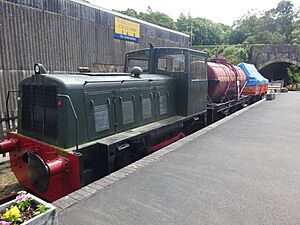Tarka Valley Railway facts for kids
Quick facts for kids Tarka Valley Railway |
|
|---|---|
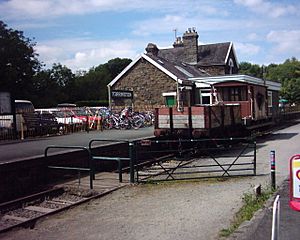
Torrington Railway Station
|
|
| Terminus | Torrington |
| Commercial operations | |
| Built by | North Devon Railway |
| Original gauge | 1,435 mm (4 ft 8 1⁄2 in) standard gauge |
| Preserved operations | |
| Stations | 1 |
| Length | 300 yards (274 m) |
| Preserved gauge | 1,435 mm (4 ft 8 1⁄2 in) standard gauge |
| Commercial history | |
| Opened | 1872 |
| Closed | 25 January 1983 |
| Preservation history | |
| 2008 | Railway society formed |
| 2013 | Planning approved for 300 yards (274 metres) of track |
| 2023 | Phase 1 complete, Phase 2 at the planning stage |
| Headquarters | Torrington |
The Tarka Valley Railway is a special heritage railway located in Devon, England. It aims to rebuild a part of the old railway line that used to run from Torrington to Bideford. So far, a short section of track, about 300 yd (274 metres) long, has been put back. This section goes towards Bideford. There's also a side track next to the old coal dock. The railway area is safely fenced off from the Tarka Trail, which is a popular path for walking and cycling. The railway team is also working hard to fix up old train carriages and engines.
Contents
History of the Railway Line
The original railway line was built by the North Devon Railway. It first opened on 18 July 1872. The London and South Western Railway operated the trains. Torrington railway station was a busy place. Trains ran from there to Bideford, Barnstaple, and even to Exeter St Davids.
In 1880, the line connected with the Torrington and Marland Railway. This was a narrow-gauge line that only carried goods. In 1923, many railway companies joined together. The Torrington to Barnstaple line became part of the Southern Railway (SR). Later, in 1925, the Torrington and Marland Railway was rebuilt to the same size as the main line. It then opened all the way to Halwill Junction. This new section was called the North Devon and Cornwall Junction Light Railway. Passengers could travel on this line until 1965. After that, it only carried goods again, until the entire line through Torrington closed completely.
Milk Trains: A Special Delivery
The Southern Railway and later the Southern Region of British Railways ran two special "milk trains" every day from Torrington. These trains carried fresh milk from the Torridge Vale Dairies. The milk went to big dairies in London, like United Dairies at Vauxhall and Express Dairies at Morden.
The milk was loaded into large tank wagons from road tankers. The first train, with eight wagons, left Torrington in the afternoon. A second, smaller train with six wagons followed later. These trains were split up at Clapham Junction in London. This was because the full milk wagons were very heavy. Part of the train would go to Vauxhall station. There, a special pipe was used to unload the milk into the creamery. The empty wagons would then go to Waterloo and return to Clapham Junction. The second milk train also split up. Some wagons went to Vauxhall, and others went to the Express Dairies depot at Morden. In the late morning, all the empty milk wagons were combined into one express train. This train then returned to Torrington. The milk trains from Torrington stopped running in 1978. This was the last milk train service on the old Southern Railway lines.
Closure of the Line
Regular passenger trains stopped using Torrington railway station in 1965. This was part of a big plan to close many railway lines across Britain. However, freight trains, carrying things like china clay and milk, continued to use the line. Sometimes, special passenger trains also ran. The line finally closed completely in 1982.
After the railway closed, the old station building was turned into a public house, which is like a pub or inn. It is still a pub today.
Preserving the Railway
In the 1990s, the railway tracks were removed. The station became a pub. However, the land where the tracks used to be was kept clear. This was in case the railway might be rebuilt one day. The land was given to Devon County Council, who turned it into a popular cycle path called the Tarka Trail.
The owner of 'The Puffing Billy' pub, which is the old station building, started collecting old train carriages and a small diesel engine. In 2008, the Tarka Valley Railway Group was formed. This group wanted to bring the railway back to life.
In 2013, the railway group received permission to lay 300 yards (270 m) of track towards Bideford. This was called Phase 1 of their project. Phase 1 is now complete. In August 2023, the preservation society ran their very first train along this new section of track!
The railway is now planning for Phase 2. This next step will extend the line by another 300 yards (270 m) to the first bridge over the River Torridge. A small stop, called a halt, will be built there. This will let passengers explore the remains of the old Rolle Canal. The group is also working to turn an old British Rail coach into a museum and education space.
Railway Vehicles and Engines
The Tarka Valley Railway has several interesting locomotives, passenger cars, and wagons.
| Name & Number | Image | Notes |
|---|---|---|
| British Rail Class 143
143617 Rod Garner |
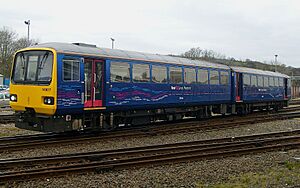 |
This train arrived at the railway in November 2022. It is painted in the green colors of the GWR. |
| Number | Image | Notes |
|---|---|---|
| BR Mk1 TSO 3924 | 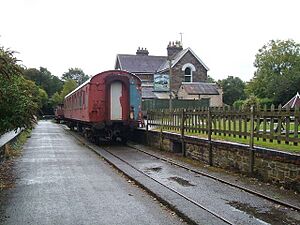 |
This coach is used as a break room for the crew. There are plans to turn it into a museum. It is painted in British Rail Green. |
| PO 653 4 wheel oil tank |  |
This old oil tank wagon has been restored. It is painted in the colors of the Bideford Gas and Coke Co. |
| BR 743169 China clay wagon | 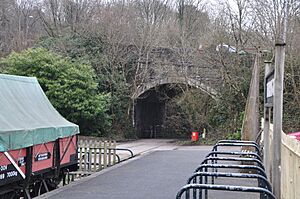 |
This wagon was used to carry china clay. |
| BR 954681 Toadfit brake van | 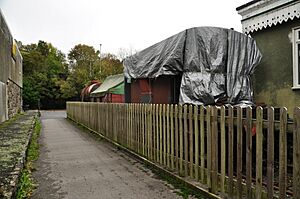 |
This brake van is being fixed up. It will be used for special brake van rides. |
| London Passenger Transport Board HW 402 Steel Hoppper "Dogfish" | This wagon arrived in July 2022 from the Swanage Railway. | |
| BR 774178 4 wheel ventilated goods van | This is just the body of a goods van. It is used as a workshop. |
Future Plans for the Railway
Phase 1 of the Tarka Valley Railway project is now complete. This included laying 300 yards (270 m) of track and building a new shop and visitor center at the station.
Now, Phase 2 is in the planning stages. This next step will extend the railway line by about another 300 yards (270 m). It will reach the first bridge over the River Torridge. A small stop will be built there. This will allow visitors to explore the remains of the old Rolle Canal. The railway team is also working on plans to turn the old BR Mk1 TSO coach into a museum and a place for learning.
See also
- Other local railway attractions:



